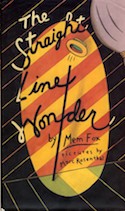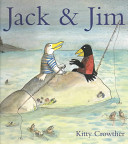by Janine Schall
 In the first two posts of this series, I briefly discussed the history of picture books with LGBT characters and provided a general overview of the representations of the LGBT characters. This week I look at books where the characters are not explicitly named or depicted as LGBT, but where they are portrayed in ways that imply an LGBT sexual orientation.
In the first two posts of this series, I briefly discussed the history of picture books with LGBT characters and provided a general overview of the representations of the LGBT characters. This week I look at books where the characters are not explicitly named or depicted as LGBT, but where they are portrayed in ways that imply an LGBT sexual orientation.
These books fall into two main groups. The first has characters whose behavior and/or interests are different from the mainstream in ways that can be read as LGBT. This includes characters with stereotypically gay behaviors, characters who transgress expected gender roles in ways that can be read as LGBT, and/or characters who are explicitly labeled as different, where those differences can read as LGBT.
Books within this group include, among others, The Straight Line Wonder (Fox, 1997), The Sissy Duckling (Fierstein, 2002), and Rough Tough Charley (Kay, 2007). In The Straight Line Wonder, three straight lines are best friends until one of the lines decides that he’s tired of being straight all the time. His friends are uncomfortable when he begins to jump in humps and twirl in whirls, and eventually they leave him alone. By the end of the book, though, the other two straight lines are bragging about being his friend since he’s become a famous movie star due to his wonderful moves. The main character in The Sissy Duckling, Elmer, is also different from everyone else. He is artistic, imaginative, and bad at sports. Elmer is rejected by his community for his behaviors, until he shows heroism by saving his father’s life. As with most of the books in this group, these two main characters are viewed suspiciously at the beginning of the story, but end up loved and accepted. However, this acceptance only comes after they do something extraordinary that is respected by others. Rough Tough Charley traces the life of Charley Parkhurst, a respected stagecoach driver in the 1800s, who was discovered to be a biological female on her deathbed, after living as a man for decades.
 The second group of books contains characters who are in an intense same sex friendship and where the plot of the story focuses on the relationship. This includes four books: Caleb’s Friend (Nones, 1993), Like Likes Like (Raschka, 1999), Jack and Jim (Crowther, 2000), and Hello, Sailor (Godon, 2003). In all of these books the relationship or something about the relationship is the central conflict of the story, though the relationship itself is portrayed positively. For example, in Jack and Jim, Jack is a blackbird from the forest who as always dreamed of flying over the sea. When he reaches the beach, he meets seagull Jim. They quickly become friends and head across the ocean to Jim’s village. Although Jack is initially rejected by the townspeople, he and Jim settle in to a life together at Jim’s house—even sharing a bed—and eventually Jack wins over the unfriendly townspeople. In Hello, Sailor, Matt is a lighthouse keeper patiently waiting for his long-delayed friend Sailor to return from sea. Although his neighbors think that Sailor is gone for good, Matt believes that he will return for Matt’s birthday so that they can sail around the world together, just the two of them, like Sailor promised.
The second group of books contains characters who are in an intense same sex friendship and where the plot of the story focuses on the relationship. This includes four books: Caleb’s Friend (Nones, 1993), Like Likes Like (Raschka, 1999), Jack and Jim (Crowther, 2000), and Hello, Sailor (Godon, 2003). In all of these books the relationship or something about the relationship is the central conflict of the story, though the relationship itself is portrayed positively. For example, in Jack and Jim, Jack is a blackbird from the forest who as always dreamed of flying over the sea. When he reaches the beach, he meets seagull Jim. They quickly become friends and head across the ocean to Jim’s village. Although Jack is initially rejected by the townspeople, he and Jim settle in to a life together at Jim’s house—even sharing a bed—and eventually Jack wins over the unfriendly townspeople. In Hello, Sailor, Matt is a lighthouse keeper patiently waiting for his long-delayed friend Sailor to return from sea. Although his neighbors think that Sailor is gone for good, Matt believes that he will return for Matt’s birthday so that they can sail around the world together, just the two of them, like Sailor promised.
While the acceptance of LGBT people and the struggle for equal rights has advanced tremendously since books with LGBT characters began to be published, picture books with LGBT characters continue to be controversial and are often challenged and/or censored when libraries or schools attempt to add them to their collections or use them with children. Books with implied LGBT characters, where the character can be read as either LGBT or heterosexual, are a less controversial way to introduce children to characters who break heteronormative patterns. These books may be easier to get published, and are definitely easier to bring into schools with fewer worries about community or parental complaints.
Next week the last post in this series will discuss picture books with transgender characters.
Children’s Literature Cited
Crowther, K. (2000). Jack and Jim. Hyperion.
Fierstein, H. (2002). The Sissy Duckling. Simon & Schuster.
Fox, M. (1997). The Straight Line Wonder. Mondo.
Godon, I. (2003). Hello, Sailor. Macmillan.
Kay, V. (2007). Rough Tough Charley. Tricycle Press
Nones, E. (1993). Caleb’s Friend. Farrar, Strauss & Giroux.
Raschka, C. (1999). Like Likes Like. DK Publishing.
Journey through Worlds of Words during our open reading hours: Monday-Friday, 9 a.m. to 5 p.m. and Saturday, 9 a.m. to 1 p.m. To view our complete offerings of WOW Currents, please visit archival stream.
- Themes: Janine Schall, LGBT literature
- Descriptors: Books & Resources, Debates & Trends, WOW Currents
